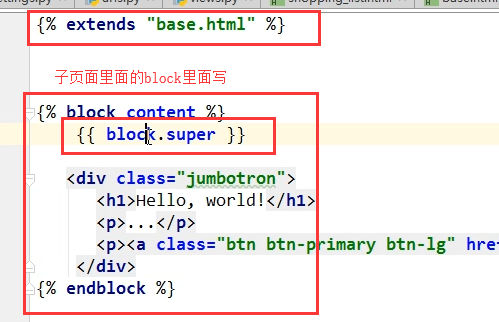备选内容(fallback)。
这种方式使代码得到最大程度的复用,并且使得添加内容到共享的内容区域更加简单,例如,部分范围内的导航。
这里是使用继承的一些提示:
- 如果你在模版中使用
{% extends %} 标签,它必须是模版中的第一个标签。其他的任何情况下,模版继承都将无法工作,模板渲染的时候django都不知道你在干啥。
- 在base模版中设置越多的
{% block %} 标签越好。请记住,子模版不必定义全部父模版中的blocks,所以,你可以在大多数blocks中填充合理的默认内容,然后,只定义你需要的那一个。多一点钩子总比少一点好。
- 如果你发现你自己在大量的模版中复制内容,那可能意味着你应该把内容移动到父模版中的一个
{% block %} 中。
- If you need to get the content of the block from the parent template, the
{{ block.super }} variable will do the trick. This is useful if you want to add to the contents of a parent block instead of completely overriding it. Data inserted using {{ block.super }} will not be automatically escaped (see the next section), since it was already escaped, if necessary, in the parent template. 将子页面的内容和继承的母版中block里面的内容同时保留

- 为了更好的可读性,你也可以给你的
{% endblock %} 标签一个 名字 。例如:
{% block content %}
...
{% endblock content %}
在大型模版中,这个方法帮你清楚的看到哪一个 {% block %} 标签被关闭了。
- 不能在一个模版中定义多个相同名字的
block 标签。
六 组件
可以将常用的页面内容如导航条,页尾信息等组件保存在单独的文件中,然后在需要使用的地方,文件的任意位置按如下语法导入即可。
{% include 'navbar.html' %}
例如:有个如下的导航栏,nav.html
<!DOCTYPE html>
<html lang="en">
<head>
<meta charset="UTF-8">
<title>Title</title>
<style>
.c1{
background-color: red;
height: 40px;
}
</style>
</head>
<body>
<div class="c1">
<div>
<a href="">xx</a>
<a href="">dd</a>
</div>
</div>
</body>
</html>
嵌入导航栏的页面,test.html
<!DOCTYPE html>
<html lang="en">
<head>
<meta charset="UTF-8">
<title>Title</title>
</head>
<body>
{% include 'nav.html' %}
<h1>xxxxxxxxxx</h1>
</body>
</html>
组件和插件的简单区别
组件是提供某一完整功能的模块,如:编辑器组件,QQ空间提供的关注组件 等。
而插件更倾向封闭某一功能方法的函数。
这两者的区别在 java script 里区别很小,组件这个名词用得不多,一般统称插件。
七 自定义标签和过滤器
这些我们后面用到的时候再讲:
1、
在settings中的INSTALLED_APPS配置当前app,不然django无法找到自定义的simple_tag.
2、
在app中创建templatetags模块(模块名只能是templatetags)
3、
创建任意 .py 文件,如:my_tags.py
from django import template
from django.utils.safestring import mark_safe
register = template.Library() #register的名字是固定的,不可改变
@register.filter
def filter_multi(v1,v2):
return v1 * v2
@register.simple_tag #和自定义filter类似,只不过接收更灵活的参数,没有个数限制。
def simple_tag_multi(v1,v2):
return v1 * v2
@register.simple_tag
def my_input(id,arg):
result = "<input type='text' id='%s' class='%s' />" %(id,arg,)
return mark_safe(result)
4、
在使用自定义simple_tag和filter的html文件中导入之前创建的 my_tags.py
{% load my_tags %}
5、
使用simple_tag和filter(如何调用)
-------------------------------.html
{% load xxx %}
# num=12
{{ num|filter_multi:2 }} #24
{{ num|filter_multi:"[22,333,4444]" }}
{% simple_tag_multi 2 5 %} 参数不限,但不能放在if for语句中
{% simple_tag_multi num 5 %}
注意:filter可以用在if、for等语句后,simple_tag不可以
{% if num|filter_multi:30 > 100 %}
{{ num|filter_multi:30 }}
{% endif %}
inclusion_tag
多用于返回html代码片段
示例:
templatetags/my_inclusion.py
from django import template
register = template.Library()
@register.inclusion_tag('result.html') #将result.html里面的内容用下面函数的返回值渲染,然后作为一个组件一样,加载到使用这个函数的html文件里面
def show_results(n): #参数可以传多个进来
n = 1 if n < 1 else int(n)
data = ["第{}项".format(i) for i in rang